From Japanese Sake to Fermented Foods: Mano Haruka’s Journey
Jan 12,2023
From Japanese Sake to Fermented Foods: Mano Haruka’s Journey
Jan 12,2023
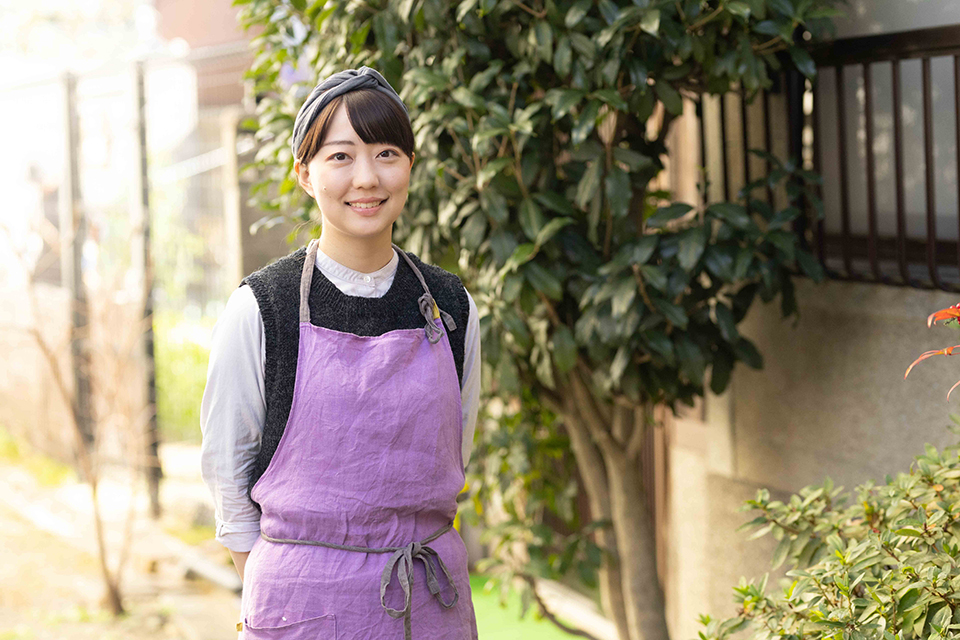

Mano Haruka — a chef who loves saké and fermentation — currently works in Tokyo and Kyoto and is active in many fields, including recipe development, writing, and teaching cooking classes. Mano says that living in Kyoto has expanded her world of fermentation. For this piece, we spoke with her about her passion for fermentation.
“My aim originally was to be a food coordinator. But then I got into saké and as I became acquainted with the producers who so conscientiously make our food, I wanted to emphasize more of the essence of food, rather than just its appearance. I traveled around the country visiting saké breweries and holding cooking classes on food and saké pairing, doing catering, and running events. While I was doing this, I noticed how well saké and fermented foods go together, which started me down the path of learning about fermented foods, like miso and soy sauce, as well as saké. At the same time, I had a strong yearning to carry on Japan’s food culture, which had for so long been centered on fermented foods.”
Although she had an intuitive sense that fermented foods pair well with saké, Mano decided to investigate in more depth exactly why they go so well together. To date, she has visited some 60 saké breweries and traveled around the country, including to Akita, Shiga, and Aichi, to visit fermentation sites in person wherever possible. One lesson that impressed her the most in her travels happened at Yamaroku Soy Sauce on the island of Shodoshima.
“I’ve heard that soy sauce is easier to understand if you think of it like wine pairings. For instance, a well-aged, dark-colored tamari soy sauce, like a full-bodied red wine, goes well with meat dishes, whereas a light usukuchi soy sauce or a quickly matured soy sauce pairs better with fish dishes. These sorts of differentiations helped guide me with saké pairings. At Yamaroku Soy Sauce, each aging barrel apparently has its own idiosyncrasies. One barrel produces a more elegant flavor, while another a more robust flavor. The brewers blend the flavors from the barrels in such a way as to ensure a consistent taste. One thing that I really found interesting was that barrels at the back of the storeroom tend to be ill-tempered, while barrels within sight of people are more likely to provide delicious soy sauce. Given these differences, I asked them that if this were true, whether they might produce special-edition products from individual barrels. And they answered that unlike saké, which is enjoyed for the uniqueness of its taste, they cannot vary the taste of soy sauce, since people depend on it as a seasoning and any change would affect the taste of their cooking. This explanation made sense to me. Although soy sauce and saké have lots in common as fermented foods, people have different expectations for seasonings and for items consumed primarily for their taste.”
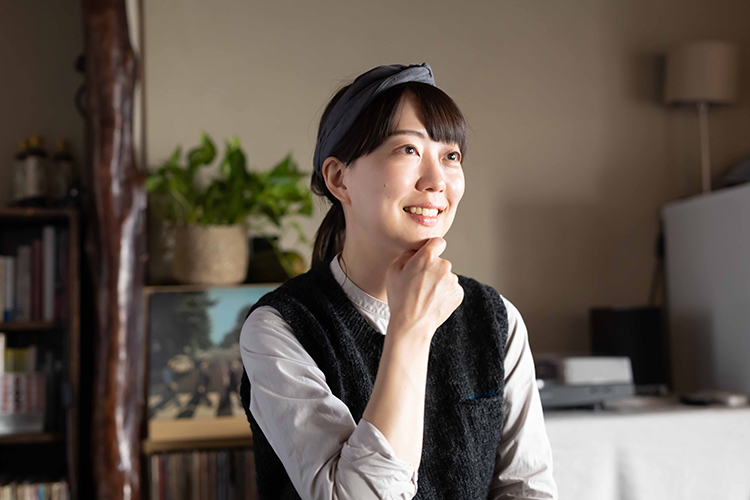
Mano’s passion to learn about fermentation extends beyond Japan to other countries. Due to the current travel restrictions, she hasn’t been able to travel outside the country, but Laos has been of particular interest to her recently.
“I have a Laotian friend and chef who uses fish from Lake Biwa in his cooking. His influence inspired me to study freshwater fish culture. I prepared the padaek [a seasoning made from fermented freshwater fish] for today’s pairings with him. The amount of fish consumed from Lake Biwa has been falling year by year, and the number of fishers is dwindling too. It’s a vicious circle, in which fewer people are eating the fish, so fewer people are bothering to catch them since it isn’t profitable anymore. I love fish from Lake Biwa, and I wish more people would eat this fish so the fishers can make a good living again. My idea is to make padaek fish sauce from unused fish (non-standard-sized fish) that can’t be used for cooking or sold on the market. Fermentation breaks down the fish and turns it into a thick paste, so you can make delicious fish sauce from fish of any size. In other words, the power of fermentation can help mitigate the problem of food loss. I sense a lot of potential in the power of fermentation. Although it might appear that Laos and Japan have little in common, they are very similar in that both countries catch freshwater fish. In my opinion, if we incorporate the fermentation food culture of other countries into Japan’s native fermented foods, new possibilities will emerge and get us to reconsider fermented foods.”
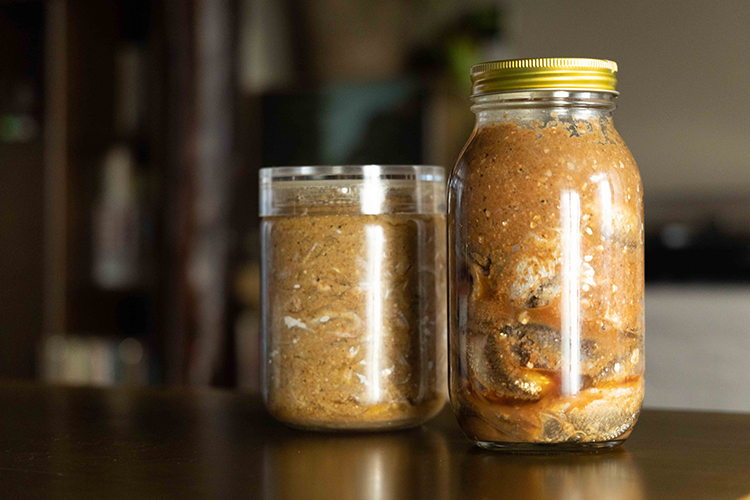
The difference in fermentation can be seen between the padaek made in 2022 (left)
and the padaek made in 2021 (right)

Mano also makes her own funa-zushi, a local fermentation delicacy featuring crucian carp from Lake Biwa
Mano says that since coming to Kyoto, her world has been quickly growing through the connections she has made with people doing interesting things in the realm of fermentation.
“Happy of Happy Taro Brewery in Shiga has a saying that ‘fermentation connects to happiness’. Happy also introduced me to the Laotian chef. And I’ve met lots of interesting people working locally with fermentation and as a result, my world has been getting bigger and bigger. There was a time previously when I thought about fermentation in a complicated way, finding all kinds of meaning in the associations between fermentation and other things. More recently, however, I’ve been keeping things simple. I still want to learn about fermented foods from all over the country, but since moving to Kyoto, I feel more strongly about putting down roots here and becoming a part of the food culture scene in the Kyoto area. I’m a person with a lot of disparate interests and I tend get involved with this thing and that thing, but I hope to buckle down more and accumulate knowledge.”
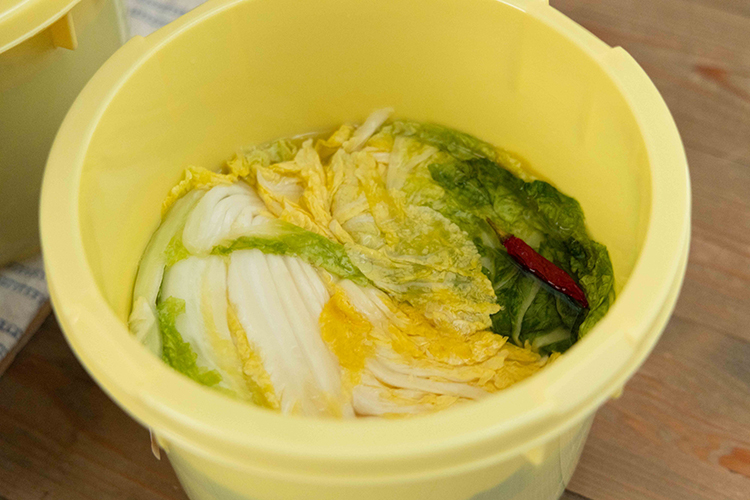
Mano also makes her own fermented Chinese cabbage. “If you can’t finish eating Chinese cabbage, add about 3 percent salt by weight to the cabbage and press it down firmly with something heavy. After a month or so, it will turn into sour pickles that are perfect for hot pot dishes.”
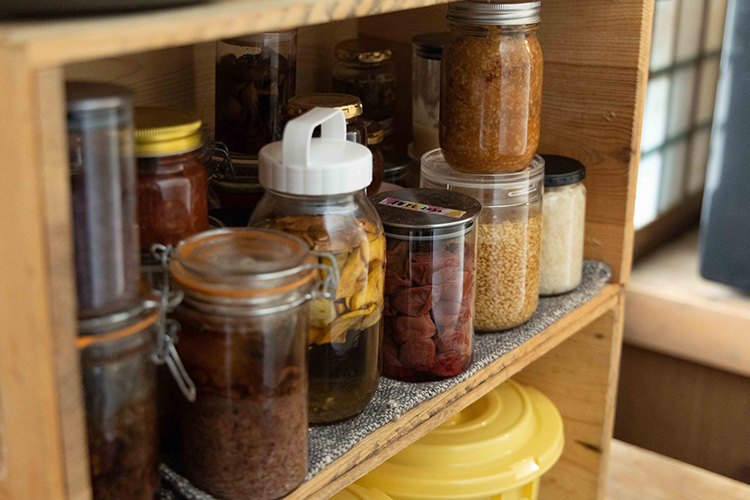
Fermented foods and preserves prepared each season include fish sauce, umeboshi [pickled plums], karin [Chinese quince] syrup, sujiebi [lake prawn] paste, bean paste made from field-grown fava beans, padaek made from pond smelt, salted koji malt, venison paste, salted brown-rice koji malt, and rice-bean miso
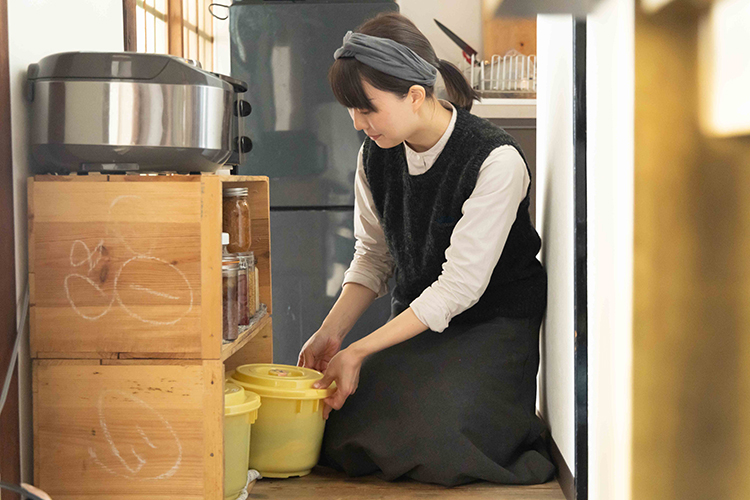
Wanting to do more herself, as well as wanting to become more rooted in the local community, Mano started a homemade cooking group in March 2022 called Yohaku Fermentation Room where people could gather and make seasonal foods together. After preparing seasonal foods such as miso, shibazuke [Kyoto-style chopped vegetables pickled in salt with red shiso leaves], and kimchi, she teaches a class in Tokyo on making meals that pair well with saké. In Kyoto, she gets together with small groups to have fun, food-making sessions with an included lunch, instead of holding cooking classes.
“The theme of my activities is making space in life through fermentation. I personally feel suffocated by modern society, which prioritizes efficiency and speed and looks for meaning and answers in everything. My idea is to foster more yohaku, or blank space, in people’s lives, which is a step back from the values of modern society, through fermentation. For example, intentionally choosing to do time and labor intensive things like making miso or making kimchi that are the polar opposite of the ‘time-saving’ mindset. Fermentation involves the occasional failure. And there are no right answers, because even when you make the same thing, you get different results. If time spent honing your senses while working with your hands and enjoying things that we don’t fully understand can create space in your mind and body, then I think that’s a good thing.”
Mano has begun a dual life of sorts, working in Tokyo and relaxing in Kyoto. Still, she says she increasingly wants to do more in Kyoto. One thing she is planning in Kyoto for 2023 is opening a liquor store with a standing bar. It is sure to become a place filled with the things Mano has done so far and what she wants to do in the future. Be sure to check her website, as she regularly posts about her activities. To wind up our interview, we asked her for her top fermented food and saké pairings.
Padaek ajitama [soft-boiled eggs marinated in padaek fish sauce] paired with Kimoto Taro Tamasakae Junmai Hiire (from Safety Well Brewery)
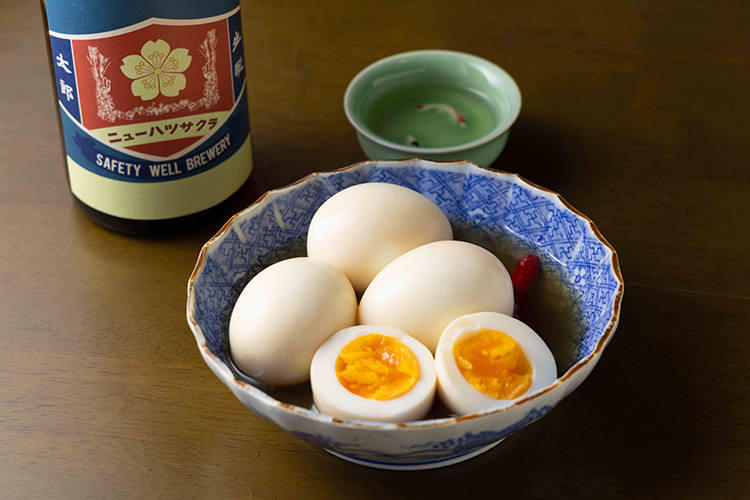
Put the padaek made from fermented freshwater fish, such as hasu [three-lips minnows], gori goby, isaza goby, moroko minnows, or funa [crucian carp], into a pot with the fish, add water, and simmer gently. Strain and dilute with more water, and then add garlic, ginger, and red pepper to make a dashi broth. Place the dashi broth into a sealable storage bag, add soft-boiled eggs, and marinate overnight to complete. The marinated soft-boiled eggs go well with Kimoto Taro Tamasakae Junmai Hiire saké from Safety Well Brewery. “The synergy between the glutamic acid in the saké with the glutamic acid and inosinic acid in the padaek really brings out the umami flavor.”
Sundubu soft tofu stew paired with Moromi Aragoshi Junmai Dobu (from Kitajima Brewery)
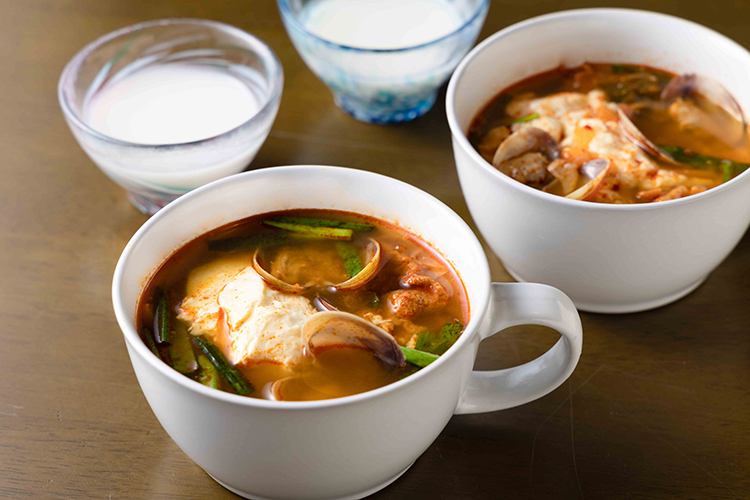
Make the stew by boiling pork, clams, kimchi, gochujang red chili paste, saké, sesame oil, ishiru fish sauce, and other ingredients with kelp and dried sardine stock. The tofu is made by hand, with soy milk and nigari bitterns, and microwaved. The tofu is added to the stew at the very end.
“Kimchi is spicy, so combining it with unrefined nigori saké mellows out the taste. This pairing goes for a visual match between the white tofu and the white unrefined saké and for a texture match between the softness of the tofu and the creaminess of the unrefined saké. Kimchi is rich in flavor, so I went with a saké that also has a distinctive flavor.”
Biwa trout fritto and funa-zushi tartar paired with Shichihon Yari Junmai Kassei Nigori-zaké (from Tomita Shuzo)
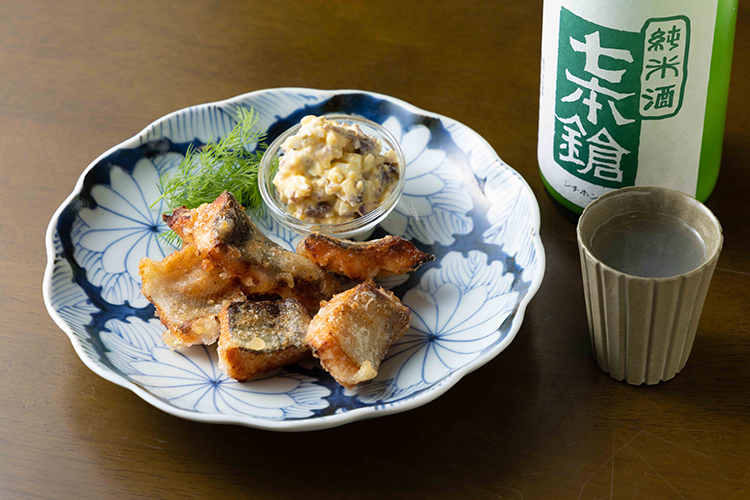
The tartar sauce is made without oil by combining funa-zushi fermented rice, strained yogurt, egg, shibazuke, and onions. “The fermented rice is the chef’s kiss,” says Mano. The fermentation imbues it with a complex and delicious flavor. The Biwa trout is seasoned with salted koji, yuzu pepper, and saké, and then coated in rice flour and deep-fried. The saké pairing is Shichihon Yari Junmai Kassei Nigori-zaké from Tomita Shuzo.
“Deep-fried foods and a sparkling saké are a good match because the saké cleanses the palate of the fattiness from the deep-fried food. The image I was going for was the combination of the rice flour’s crispy texture and the saké’s fizzy mouthfeel.”
Each singular pairing is exquisite and provides a sense of the playfulness and depth of fermentation.
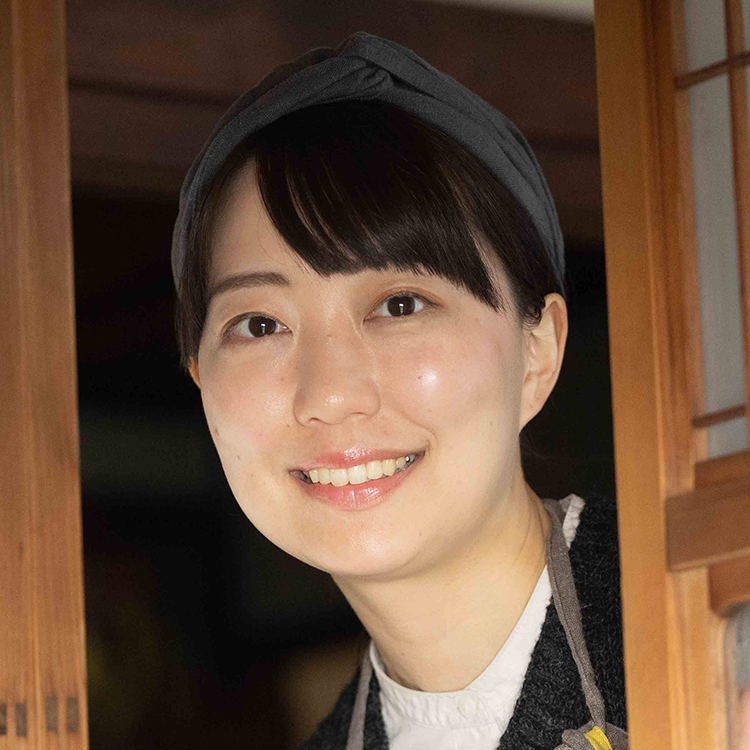
Chef and owner of Yohaku Fermentation Room
Chef and owner of Yohaku Fermentation Room
Mano is active in many areas, such as recipe development and writing articles, with a focus on suggesting dishes that pair well with saké. With the launch of the Yohaku Fermentation Room in 2022, she began a series of activities that create space in people’s lives through fermentation. She sees accumulating such spaces as her life’s work. Her published works include Easy and Delicious Fermented Food Recipes (Seibido Shuppan).
https://www.harukamano-jozo.com/